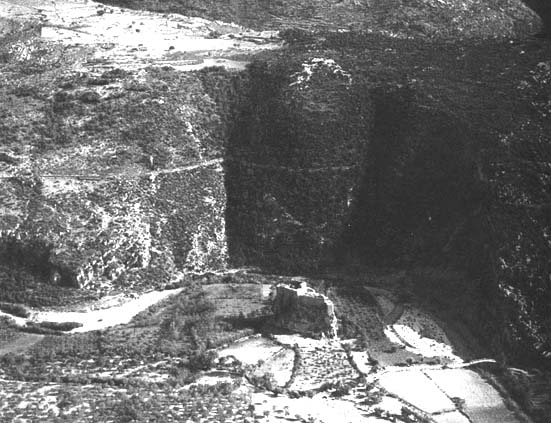
| ||
|
Friday, December 27, 1996
LebEnv #18 TRAGEDY OF A HISTORICAL SITE - MSEILHA CASTLE by Fareed Abou-Haidar
|
||
 © Elie Wardini.
|
||
|
In June 1971, I went with my parents to the old castle of Mseilha,
thought to have been built by the Crusaders, but likely built by the Arabs in
the 13th or 14th century. From Batroun, a narrow paved road wound through
dense vegetation along the south bank of the Nahr el-Jawz (Walnut River),
with the mountains just to the right of the road. Some three kilometers in,
the greenery opened up to reveal the castle on its rock in the middle of a
cultivated clearing surrounded by low green hills. We parked the car and
crossed an old arched stone bridge over the river. Access to the castle was
on a short, narrow pathway through a dried-out, potentially snake-infested
field. A narrow staircase of carved stone zigzagged up the side of the rock
to the castle. There was a small handful of people in the area. Inside was a
small maze of corridors, rooms, doorways, arches, stairs and niches that I
explored with interest. There were also a couple of holes in the ground; a
peek revealed dungeons or water reservoirs.
In Summer 1993, I went on a trip back to Lebanon. I took a bus trip to The Cedars. This would be my first trip to North Lebanon since 1971, and I dreaded what I might see in the area of Mseilha. A freeway had been built through the valley of Nahr el-Jawz. That, I figured, would have destroyed the splendid isolated setting of the castle. Worse, I had heard that a rock/gravel quarry had been built next to the castle. The freeway went inland behind Ras Shikka where the bus pulled over to give us a chance to see the castle of Mseilha. I had heard for years about this, but nothing could have prepared me for it. The once-isolated castle in the little valley surrounded by green hills now had a huge rock quarry as a backdrop that, in two separate pits, had all but destroyed the steep hills. Bulldozers had pushed huge rocks to the edge of the ancient arched bridge over Nahr el-Jawz (Walnut River), threatening to bury it. The greenery along the river was gone. A few tourists were climbing the stairway to the castle. A haze of white dust enveloped the sorry scene. As our host complained about the quarry, people were aghast, commenting about in low voices about the horror. I wondered what the French tourists on the bus thought of this, coming from a country where effort went into saving every landmark, no matter how small. I took pictures through the bus window. (E-4, E-5 photos Fareed Abou-Haidar) Back in Beirut, I wrote a letter to Louis el-Hajj at Al-Nahar newspaper. A copy of it was delivered to the Environment Ministry with the help of Asa'ad Serhal of The Society for the Protection of Nature and Natural Sites in Lebanon (SPNL). It was printed on Wednesday, December 1, 1993. The following is my English translation of it: "When the first government of the Gemayel Administration was announced near the end of 1982 , I wrote to "Al-Nahar" asking, "Where is the Environment Ministry?" because of its absence from that government after its foundation during the Sarkis administration. Once again, I ask, "Where is the Environment Ministry?", this time in reference to its absence from Mseilha Castle. Recently, and after a long absence from Lebanon, I went on a guided trip to The Cedars and saw Mseilha for the first time since 1971. I was shocked when I saw the quarry that had decimated the green hills that used to surround this unique little castle. The bulldozers continue to remove the hills, dumping rocks up to the edge of the historical bridge and threatening to destroy it. Mseilha castle has become a shame for the Lebanese people and their government, especially in front of tourists coming from countries that seek to protect every historical site, no matter how small. Where is the Environment Ministry? Where's the government? Three years after the end of the war, I ask of the Lebanese government, and especially the Environment Ministry, to close that horrible quarry immediately and to work to rehabilitate and reforest the place. Also, the government should declare the castle and its vicinity a historical preserve. Then can we call ourselves a civilized country. If we cannot protect our important historical sites, how can we hope to protect the rest of this beautiful little nation and its natural sites from the Bulldozer Blitzkrieg?" During my stay in Lebanon in 1993, a fight was brewing between the various environmental groups and the government on one side, and the rock quarry operators on the other side. The Mseilha quarry was closed very soon after I saw it. I later heard that it had reopened. In 1995, I went on another trip to North Lebanon and got another fleeting view of the devastation. I could not see the bridge. Had the careless owner and the indifferent people driving the bulldozers destroyed it (along with the river)? Or was it behind a pile of soil? Or did I look in the wrong place? I could not tell if the quarry was still functional.
Overview of the site in the 1960's. (From a Tourist Board brochure, 1964) (See also "MsaylHa" under "Places" on Al Mashriq's Lebanon page.) Information on this subject is welcome from those of you who have recently been to Lebanon. By the way, Mseilha castle appears on the L.L. 25 note, which I believe is no longer in circulation or is rarely used. (See other photographs from some of the areas mentioned above.) | ||

Created 961231
